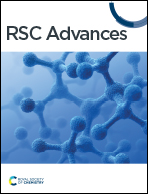Activated carbon from Camellia oleifera shells for adsorption of Y(iii): experimental and DFT studies
Abstract
Yttrium is an important rare earth element and is widely used in fields such as special glass preparation, metallurgy, and materials science. However, it is difficult to recover yttrium ion waste from dilute solutions with traditional processes, resulting in a significant waste of rare earth resources. The simple, effective, and easy-to-operate adsorption method is the most promising method for recovering yttrium, which is of great significance for sustainable development of the rare earth industry. In this study, activated carbon was prepared from Camellia oleifera fruit shells (COS) using phosphoric acid activation, and efficient recovery of Y(III) from the Camellia oleifera fruit shell activated carbon was studied. Adsorption equilibrium data showed that this activated carbon had a Y(III) adsorption capacity of 35.41 mg g−1, indicating significant potential for recovery of yttrium ions. The adsorption of Y(III) by the activated carbon prepared from COS was consistent with the Langmuir model, and the adsorption data were consistent with the pseudo second-order kinetic model, indicating that the adsorption process was primarily chemical adsorption. After adsorption, the surface of the activated carbon contained large amounts of N, O, and Y, indicating that Y(III) was stably adsorbed. The mechanisms for adsorption of Y(III) on three types of activated carbon were studied through DFT calculations. The results showed that Y(III) interacted with the carbon atoms on the surfaces to form new chemical bonds. The yttrium ion adsorption capacities for the three different activated carbons decreased in the order C I > C II > C.



 Please wait while we load your content...
Please wait while we load your content...